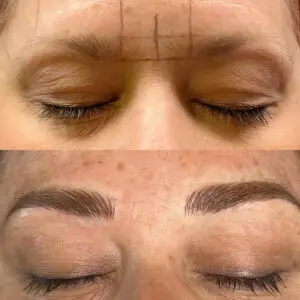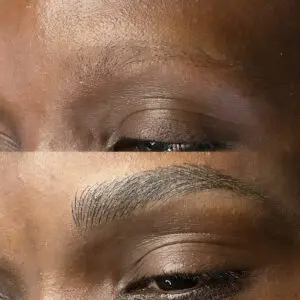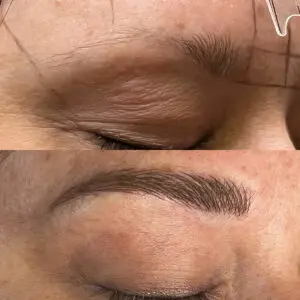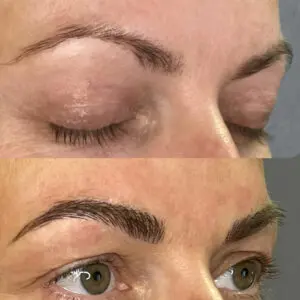Microblading is a semi-permanent makeup technique using a handheld tool to tattoo hair-like strokes onto the eyebrows. It’s a popular choice for those looking to enhance their eyebrows’ shape, fullness, or symmetry. Here’s a closer look at what you need to know about microblading eyebrows:
The process of microblading
The benefits
The aftercare
The healing
After getting microblading, it’s normal for the eyebrows to look darker and more defined immediately after the procedure. The eyebrows may also be swollen and slightly red. These effects should subside within a few days.
It typically takes about one week for the eyebrows to fully heal from microblading. During this time, it’s important to follow the aftercare instructions provided by your technician to ensure the best possible results. This may include avoiding water, sweat, and makeup on the eyebrows for at least a week and applying a healing ointment or moisturizer to the eyebrows to keep them moisturized.
After the initial healing period, it’s normal for the pigment in the eyebrows to appear softer and more subtle. This is because the pigment is not as deep as it was immediately after the procedure. However, it can take several weeks for the pigment to settle fully and for the final results to become apparent.
Overall, it takes about one week for the eyebrows to fully heal from microblading, but it can take several weeks for the pigment to fully settle and the final results to become apparent.
The cost $$$
The cost of microblading can vary depending on the location, the technician’s experience level, and the job’s complexity. On average, you can expect to pay anywhere from $400 to $800 for a microblading session. Some salons offer touch-up sessions at a reduced rate, which may be necessary to maintain the results.
The difference between Microblading and eyebrow tattooing are both techniques used to enhance the appearance of eyebrows, but they differ in several key ways:
- Method: Microblading uses a handheld tool to draw hair-like strokes onto the skin using a pigment. The pigment is chosen to match the color of the client’s natural eyebrows. Eyebrow tattooing, on the other hand, uses a machine to tattoo the pigment into the skin. This results in a more solid, filled-in look compared to the hair-like strokes of microblading.
- Duration: Microblading is considered a semi-permanent makeup technique, as the results typically last for one to two years before fading. Eyebrow tattooing is a more permanent solution, as the pigment is tattooed into the skin and cannot be easily removed.
- Aftercare: After getting microblading, following specific aftercare instructions is vital to ensure the best possible results. This typically involves avoiding water, sweat, and makeup on the eyebrows for at least a week. Eyebrow tattooing typically requires less aftercare, as the pigment is tattooed deeper into the skin and is less likely to fade or smear.
- Pain: Both microblading and eyebrow tattooing can be uncomfortable, but microblading is generally considered to be less painful. Some people report feeling slightly stinging during the procedure, but it is generally well-tolerated. Eyebrow tattooing is often described as more painful, as the machine used can be louder and the needle goes deeper into the skin.
How long does it last?
Factors that can affect the longevity of microblading include:
- Skin type: Some skin types may absorb pigment more readily than others, which can cause the results to fade more quickly. People with oily skin may find that the results of microblading disappear faster, as the oils in the skin can cause the pigment to break down.
- Skincare routine: Proper skincare can help to extend the life of microblading. It’s essential to avoid exfoliating or using harsh skincare products on the eyebrows, as this can cause the pigment to fade more quickly. Also, be mindful that using retinol creams will shorten the life of your microblading pigment.
- Sun exposure: Exposure to the sun can cause the pigment in microblading to fade faster. Using sunscreen on the eyebrows is important to protect the pigment and help them last longer.
- Touch-ups: Most people will need to get touch-up sessions to maintain the results of microblading. These sessions can help to fill in any areas that have faded and restore the overall shape of the eyebrows. Touch-up sessions are typically done every six to twelve months, depending on the individual’s needs.
Is microblading painful?
Some people may experience discomfort during the procedure, but it is generally well-tolerated.
The level of pain experienced during microblading can vary from person to person. Some people report feeling a slight stinging sensation during the procedure, while others may not feel much discomfort at all. The level of pain can also depend on the individual’s pain tolerance and the skill of the technician.
To minimize discomfort during the procedure, the technician may apply a numbing cream to the eyebrows before beginning the microblading process. This can help to reduce any discomfort or pain during the procedure.
It’s important to remember that microblading is a relatively quick and painless procedure compared to other types of tattooing. If you are concerned about the pain of microblading, it’s a good idea to discuss this with your technician before the procedure. They can help address any concerns you may have and provide additional information on what to expect during the process.
Overall, microblading is a popular choice for those looking to enhance the appearance of their eyebrows. It can give you natural-looking, full eyebrows without the need for daily maintenance and can be a good option for those with thin or uneven eyebrows. However, it’s important to carefully research your chosen technician and follow the aftercare instructions provided to ensure the best possible results.





